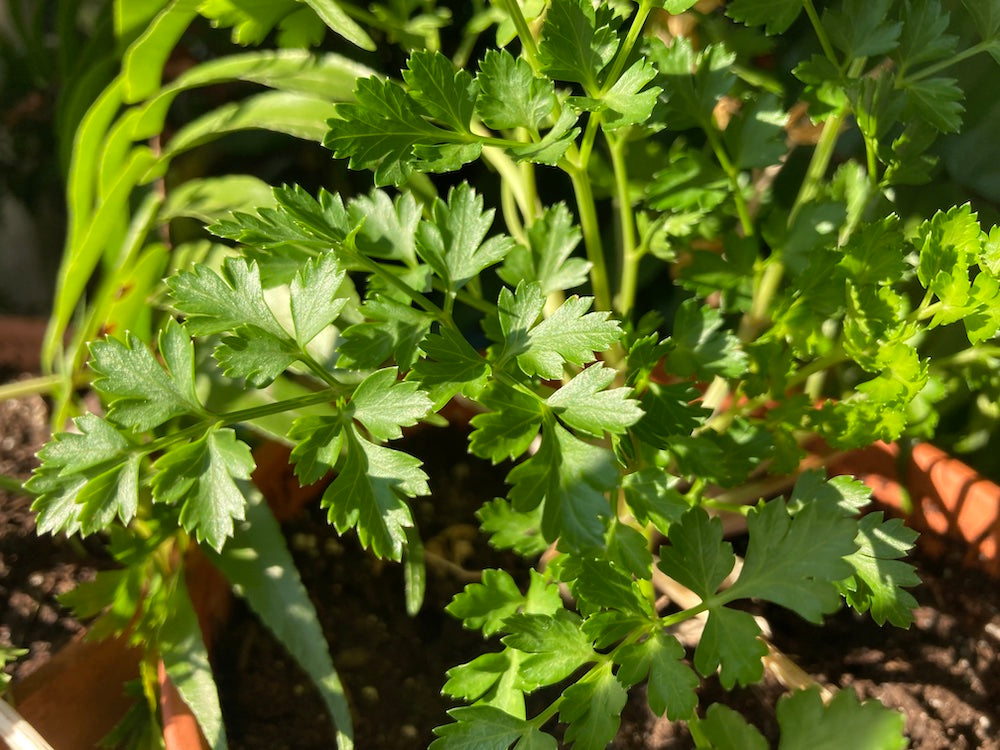Growing Herbs on Windowsills
Share
For me, growing herbs indoors in a sunny window is way more satisfying than growing houseplants. Why is that? While both houseplants and herbs add that much-needed touch of fresh green to an interior when the exterior is different shades of brown, only herbs provide you with something to harvest and use. While my cat might find it delightful to nibble on the ends of my philodendron (shoo, Buddy!), fresh herbs grown at hand can satisfy the rest of the family in soups, stews, sauces, and infusions.

Choosing the Best Window
Don’t worry about setting up a fancy lighting system. Your herbs can access quite a bit of light with just a sunny window. The best light in winter comes through your south-facing windows. Even if you have deciduous trees or shrubs near those windows, the season’s lack of leaves will let in more light. Shoot for a window that offers 4-6 hours of light each day.

Avoid teetering herb pots! You’ll want a window with either a deep-set sill, an adjacent counter or space under which you can set up a table. If you arrange several herb pots in a window, be sure to move them now and then back to front, side to side and rotate the pots themselves so they can grow as evenly as possible.
Protect your sills and counters with some sort of tray or pot (no holes!) to catch water. A pot dish, a plant tray or even a baking sheet pan should keep your sills and tables watermark-free.
Herbs Love Humidity
The winter air inside a home is as dry as the Sahara! If your skin feels dry, your plants are parched, too. A pebble-filled tray or dish can help. Set your pots on the pebbles and fill the tray with water up to the top of the pebbles. As the water evaporates from around the pebbles, the air around the herbs becomes more humid. Your plants and maybe your own skin will feel the difference. Your herbs also benefit from an occasional misting of their leaves.
Soil and Amendments
Indoor herbs benefit from the same soil and amendments that houseplants benefit from. Our Premium Blend Potting Soil is ideal for potted indoor plants. It is chock-full of compost and worm castings, making it an extraordinary moisture-retentive mix. Spreading a 0.5-0.75” layer of Pure Rice Hulls on top of the Premium Blend Potting Soil helps deter those annoying fungus gnats. And if you mix it into your potting soil, the rice hulls increase porosity and drainage.
What Herbs to Grow
I’m constantly reaching for fresh herbs to add flavor to my dishes, no matter the season. These herbs are easiest for folks with limited experience and limited window space:

Basil: Put this at the front of your indoor herb garden as it needs plenty of light. Use fresh leaves for homemade pizza, chopped leaves for egg/tofu scrambles or harvest a whole bunch for pesto.
Parsley: A moderate light plant, parsley seems undeterred by lower humidity and temperatures. Use it to top soups and stews.
Thyme: Choose a variety that’ll fit your space as some are more compact than others. Watch for its leaves to dry out—you often can’t tell that they are parched! I’m constantly adding this to homemade salad dressings and mushroom dishes.
Chives: It’s an excellent indoor herb due to its straight-up, compact growth. Just snip off the tips and add to soups, stews, eggs, cream cheese and butter for an added mild onion flavor.

And why should the humans have all the fun? Add a pot of “cat grass” (can be oats, barley, rye, or winter wheat seeds) to your indoor herb collection for your feline friends. Maybe they’ll be satisfied and will stop eating your houseplants.



